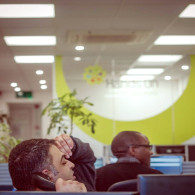Lighting is a critical part of the workplace environment; together with air quality, temperature and noise levels, it’s one of the biggest factors affecting workplace well-being. The physical environment has a huge impact on employee well-being, as Public Health England reported in August 2015. 1Physical Environments and Employee Wellbeing So how do you harness your environment to optimise the positive effects of good lighting?
1. Consider how the space will be used
 This may seem obvious, but you should think about not just how it’s going to be used now, but also how usage may need to change to reflect future requirements. For example, open plan offices need to be flexible, the lighting scheme needs to be able to adapt for any likely changes, preferably without the need to move a large number fittings – using a flexible lighting control system such as a full DALI installation can help here. Our lighting has a typical lifespan of around 15 years, often longer. Therefore, it’s essential to make sure that what you are specifying can be reconfigured to adapt to the future needs of the building’s occupiers. After all, who knows how the workplace will have changed in 10 or 20 years time?
This may seem obvious, but you should think about not just how it’s going to be used now, but also how usage may need to change to reflect future requirements. For example, open plan offices need to be flexible, the lighting scheme needs to be able to adapt for any likely changes, preferably without the need to move a large number fittings – using a flexible lighting control system such as a full DALI installation can help here. Our lighting has a typical lifespan of around 15 years, often longer. Therefore, it’s essential to make sure that what you are specifying can be reconfigured to adapt to the future needs of the building’s occupiers. After all, who knows how the workplace will have changed in 10 or 20 years time?
2. Use available natural light
 The amount of light we receive from the sun changes depending on the season and the time of day. Daylight sensing controls, which optimise the use of natural light, will save your clients money on energy bills. Studies have shown that spaces using daylight sensing controls can reduce power consumption by 20-60% .2Littlefair, P. J. (2001). Photoelectric control: the effectiveness of techniques to reduce switching frequency. Lighting Research and Technology, 33, 43-55 3((Roche, L. (2002). Summertime performance of an automated lighting and blinds control system. Lighting Research and Technology, 34, 11-25 There is also a strong relationship between workplace daylight exposure and office workers’ sleep, activity, and quality of life.4Chueng, I. (2013). Impact of workplace daylight exposure on sleep, physical activity, and quality of life. American Academy of Sleep Medicine, 36. However, it is important to moderate excessive light levels to reduce glare. This can be achieved by using simple measures such as blinds or window treatment.
The amount of light we receive from the sun changes depending on the season and the time of day. Daylight sensing controls, which optimise the use of natural light, will save your clients money on energy bills. Studies have shown that spaces using daylight sensing controls can reduce power consumption by 20-60% .2Littlefair, P. J. (2001). Photoelectric control: the effectiveness of techniques to reduce switching frequency. Lighting Research and Technology, 33, 43-55 3((Roche, L. (2002). Summertime performance of an automated lighting and blinds control system. Lighting Research and Technology, 34, 11-25 There is also a strong relationship between workplace daylight exposure and office workers’ sleep, activity, and quality of life.4Chueng, I. (2013). Impact of workplace daylight exposure on sleep, physical activity, and quality of life. American Academy of Sleep Medicine, 36. However, it is important to moderate excessive light levels to reduce glare. This can be achieved by using simple measures such as blinds or window treatment.
3. Give people control
 Giving employees more control of their environment has been shown to improve their performance and job satisfaction.5Gensler 2013 US Workplace Survey Using individual task lighting is one way to allow individuals to tailor light levels to their needs. However, newer sophisticated lighting systems can allow users to program individual plans for different zones according to the requirements of the occupants. For example, the lighting system could detect when an individual logs into their workstation and automatically adjust the lighting to their preferences.
Giving employees more control of their environment has been shown to improve their performance and job satisfaction.5Gensler 2013 US Workplace Survey Using individual task lighting is one way to allow individuals to tailor light levels to their needs. However, newer sophisticated lighting systems can allow users to program individual plans for different zones according to the requirements of the occupants. For example, the lighting system could detect when an individual logs into their workstation and automatically adjust the lighting to their preferences.
At Lighting Partners London we happily advise on all aspects of interior lighting, feel free to contact us for any help you need.
References
| 1. | ↵ | Physical Environments and Employee Wellbeing |
| 2. | ↵ | Littlefair, P. J. (2001). Photoelectric control: the effectiveness of techniques to reduce switching frequency. Lighting Research and Technology, 33, 43-55 |
| 3. | ↵ | ((Roche, L. (2002). Summertime performance of an automated lighting and blinds control system. Lighting Research and Technology, 34, 11-25 |
| 4. | ↵ | Chueng, I. (2013). Impact of workplace daylight exposure on sleep, physical activity, and quality of life. American Academy of Sleep Medicine, 36. |
| 5. | ↵ | Gensler 2013 US Workplace Survey |

